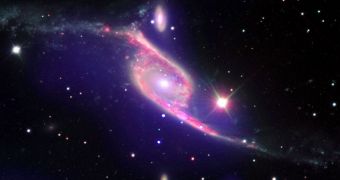The southern constellation of Pavo is at this point the host of a peculiar case of galactic cannibalism, taking place between the galaxies NGC6872 and IC4970. The former is the larger one, seen here at the center of the image, while the latter is the small one in the upper part of the photo. The two galaxies were recently discovered to be exhibiting a previously unseen phenomenon – it would appear that gas from one of them is feeding the other's black hole, which is cocooned inside a protective layer of cosmic dust and gas, Space Fellowship reports.
The massive mash-up was recently imaged by a host of three telescopes, among the most advanced and renowned on the surface of the planet. Because the active galactic nucleus (AGN) at the core of IC4970 is clouded by dust and gas, it is nearly invisible for observatories operating in optical wavelengths. The European Southern Observatory's (ESO) Very Large Telescope (VLT) tried unsuccessfully to breach the wall around the black hole, but failed to do so. After the attempt, panoramic images of the gigantic collision were taken in great detail.
The only solution to penetrate the massive veil was to use observatories that operated either in infrared or in X-ray wavelengths. And what better instruments to do this than two of NASA's four Great Observatories, the Chandra and Spitzer space telescopes. The orbit-based satellites were able to pierce the clouds surrounding the black hole, and imaged the light emitted by the matter that heated up in its accretion disk, before finally collapsing through the event horizon, and getting crushed.
While studying the AGN, Chandra made an impressive discovery, namely the fact that there wasn't sufficient gas in IC4970 to allow for the continuous growth of the black hole at its core. Astronomers naturally wondered where the gas was coming from, and the answer came from the other galaxy, NGC6872. It would appear that the strong gravitational pull of the giant behemoth is able to basically pull its “food” from the deep reservoir of cold gas that Spitzer evidenced at the core of the larger space structure.
The new image is an example of the wonderful and advanced astronomy that can be produced from combining the world's most renowned telescopes on single targets in the sky. The photo shows the VLT visible-light portion of the image in red, green and blue, the Spitzer infrared data in red, and Chandra's X-ray readings in purple.

 14 DAY TRIAL //
14 DAY TRIAL //